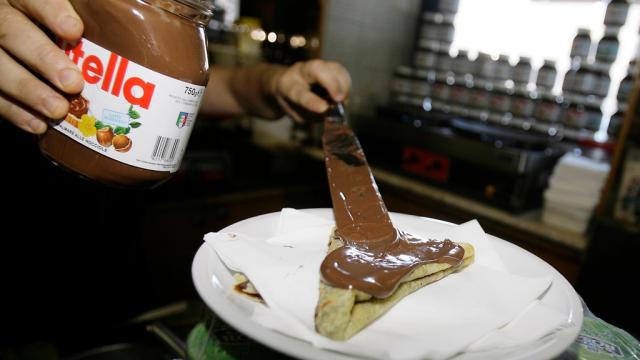If you were on social media yesterday, you probably noticed that Nutella has joined the long list of good things that supposedly cause cancer, like alcohol, red meat and maybe coffee. The trouble is, scientists never said that Nutella causes cancer.
Image: AP
There’s definitely a food safety problem afoot, and Nutella is a part of it. This past May, the European Food Safety Authority (EFSA) announced there were carcinogenic contaminants in one important Nutella ingredient, palm oil. But there are carcinogens in plenty of things you enjoy daily, and the palm oil in Nutella isn’t enough to cause you harm (unless you’re this guy). So don’t stop eating your favourite chocolate-hazelnut spread until you hear us out.
The excitement seems to have started yesterday, when Reuters reported that Nutella maker Ferrero, which is based in Italy, said it could not substitute palm oil out of its spread, as doing so would lead to an inferior product. Ferrero was also considering its bottom line: Palm oil costs $US800 ($1066) a ton, compared with $US845 ($1126) for sunflower oil and $US920 ($1226) for rapeseed oil. While the EFSA hasn’t yet put a ban or limit on palm oil following its report, a popular Italian supermarket stopped stocking palm oil-containing products on its shelves. Lots of things still contain palm oil, because it’s basically tree-grown margarine. Oreos, for example.
Here’s the science: Palm oil, one of Nutella’s most important ingredients, contains high levels of chemicals called “free and esterified 3-monochloropropane-1,2-diols” (MCPD) and “glycidyl esters”. We’ll call them 3-MCPD and GE. On average, Europeans were consuming between 0.2 and 1.5 micrograms per kilogram of their weight per day in 3-MCPD, and between 0.1 and 0.9 of glycidol, which turns into GE, according to an EFSA report issued last May. The EFSA scientists cited studies showing that 3-MCPD could cause kidney problems in mice, and that GE could cause tumours in rats and mice.
How do these chemicals get into palm oil in the first place? During the processes used to rid the oil of its colour and smell. “These can form GE and eventually 3-MCPD during the very harsh refining of palm oil, particularly deodorization above 250 degrees Celsius,” Alejandro Marangoni, a professor of food science at the University of Guelph in Canada, told Gizmodo in an email. “No heat, no problem,” he said, but “the industry [is] very concerned about this and has been aware of it for over a decade”.
So the scientists behind the EFSA report established 0.8 micrograms per kilogram per day as a safe 3-MCPD level. Generally, adults and teens eat less than this amount, but infants eat more, likely due to the 3-MCPD in their formula, according to the report. That 0.8, it should be noted, is a lot lower than the 77 micrograms per kilogram per day that the scientists established would cause a 10 per cent increase in the chance of seeing adverse events.
As for glycidol, the scientists determined that 10.2 milligrams per kilogram per day of the stuff could cause tumours in 25 per cent of rats. Again, infants receiving formula fell into the concern range, which is to say, they drank around 1/5500th of the amount that could potentially cause harm based on rat tests. Adults generally consumed less than 1/25,000th of that harmful amount, which according to the scientific report is outside the expert-defined concern range.
Still with me?
All this is to say, everyone is hooting and hollering about Nutella causing cancer. The EFSA’s paper seems to indicate that palm oil might add to some health troubles, but Nutella isn’t the biggest concern compared to other palm oil sources, or for children whose Nutella intake should, frankly, be rather limited anyway.
Not convinced? Let’s do a calculation. I weigh around 69kg, which means I can have 55 micrograms of 3-MCPD per day (that’s 69 times the scientist-recommended dose of 0.8). As far as glycidol goes, back-of-the envelope, I shouldn’t have more than 28 micrograms of it — the paper doesn’t publish a recommended maximum amount as it does for 3-MCPD, so I just multiplied my 69 kilograms by 10.2 milligrams, the dangerous amount, and divided it by 25,000, that concern boundary I mention above.
According to the report, palm oil contains 2912 micrograms of 3-MCPD and 3955 micrograms of glycidol per kilogram. Twenty per cent of Nutella is palm oil. If I ate 35 grams of Nutella, I’d eat seven grams of palm oil and get to that 28 micrograms of glycidol number that appears to be a safe maximum. So, if I’m really worried about cancer, I’ll eat less than 35 grams a day.
There are a lot of other reasons to limit your palm oil intake. The palm oil industry is a major greenhouse gas emitter, and has cut down biodiversity-rich rainforests in Southeast Asia, according to Scientific American. But don’t let headlines about cancer be your main reason not to eat Nutella. The Reuters story says that “Ferrero is the only big European food company to mount such a public defence of the use of the ingredient in its products following the EFSA opinion”, but of course, that’s been twisted into headlines like “Does Nutella Cause Cancer?” and “Study Claims Nutella Causes Cancer“. The study in question doesn’t contain the word “Nutella”.
We reached out to Nutella as well as the EFSA for comment but had not heard back at time of writing.
